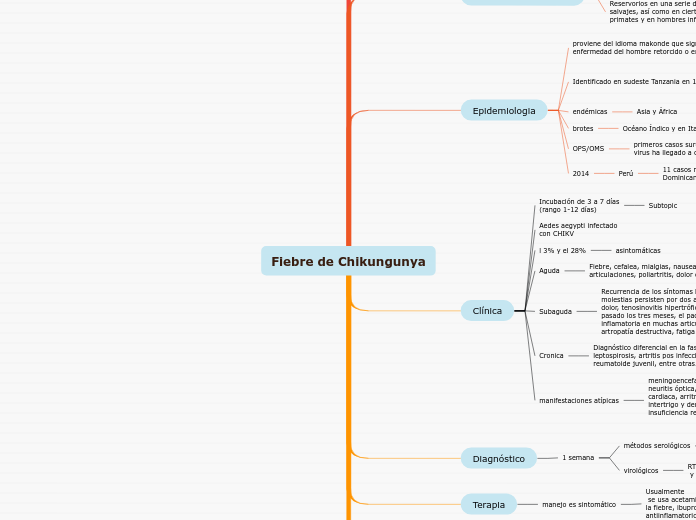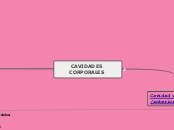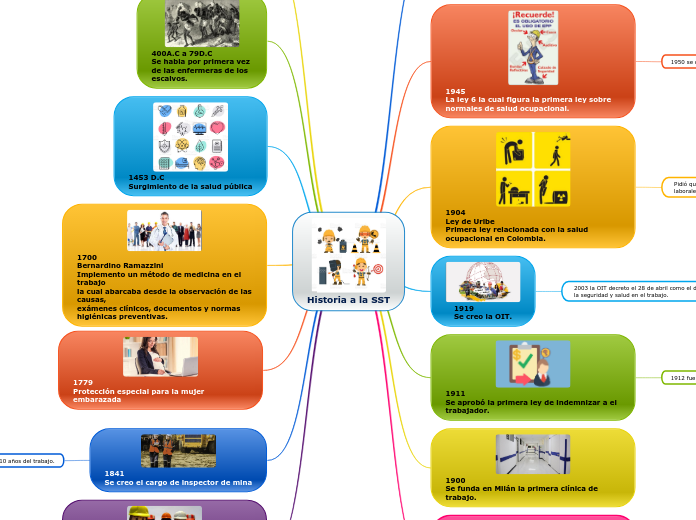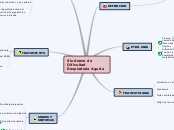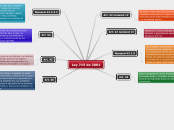Fiebre de Chikungunya
To name your story, you have to think about the overall message and what you want your audience to understand from the story. Also, make it relevant and easy to remember.
Prevención y control
Usar ropa que cubra la máxima superficie posible de piel, aplicar repelente de mosquitos en la piel expuesta y en la ropa, siguiendo sus instrucciones de uso, utilizar mosquiteros para proteger a los niños, ancianos y enfermos.
Utilizar mallas, mosquiteros en ventanas y puertas para disminuir el contacto con el insecto.
Los directivos de las regiones, de las municipalidades, obliguen a las personas a usar floreros sin agua o usar arena húmeda en los cementerios.
Eliminar todo objeto que ya no se use y pueda acumular agua, mantener limpios el techo y patios de la vivienda.
La nebulización de insecticidas en ULV (volumen ultra reducido): Piretroides, preferentemente en base acuosa, AquaReslin®, Super y Solfac® EW 050 (permetrina 10,87%, esbioletrina 0,51% y butóxido de piperonilo 11,07% o ciflutrina 5%); estos insecticidas no son tóxicos para los humanos.
De no poder ser eliminados los recipientes en los techos de las casas, se deberá colocar “boca abajo”, y los cilindros y tanques de agua tienen que ser tapados. En el caso de los floreros deberán usar arena húmeda.
Los pobladores deben identificar los probables depósitos que podrían ser “criaderos” del mosquito.
Lavar diariamente los bebedores de los animales.
Eliminar los huevos de los envases secos que han contenido agua y que se encuentran sin tapa,el embrión es capaz de resistir largos períodos de desecación (meses o hasta por más de 1 año), al volver a tener contacto con elagua la eclosión se da en tan sólo alrededor de 15 minutos.
Búsqueda y eliminación del Aedes aegypti y tratamiento o eliminación de los criaderos.
Terapia
manejo es sintomático
Usualmente
se usa acetaminofén o paracetamol para el alivio de la fiebre, ibuprofeno, naproxeno o algún otro agente antiinflamatorio no esteroideo
Diagnóstico
1 semana
virológicos
RT–PCR
y aislamiento del virus
métodos serológicos
(ELISA para
la detección de IgM e IgG
Clínica
manifestaciones atípicas
meningoencefalitis, encefalopatía, síndrome cerebeloso, parestesias, neuropatía y parálisis; oculares: neuritis óptica, iridociclitis, episcleritis, retinitis y uveítis; cardiovasculares: miocarditis, pericarditis, falla cardiaca, arritmias e inestabilidad hemodinámica; dermatológicas: hiperpigmentación fotosensible, intertrigo y dermatosis vesicular; renales: nefritis e insuficiencia renal aguda; respiratorias: neumonía e insuficiencia respiratoria; y otras manifestaciones: hepatitis, pancreatitis e hipoadrenalismo.
Cronica
Diagnóstico diferencial en la fase aguda incluye especialmente al dengue y a la leptospirosis, artritis pos infecciosa (fiebre Malta, gonococo diseminado), artritis reumatoide juvenil, entre otras.
Subaguda
Recurrencia de los síntomas luego del episodio agudo, las molestias persisten por dos a tres meses con exacerbación del dolor, tenosinovitis hipertrófica subaguda, y la forma crónica, pasado los tres meses, el paciente persiste con artralgia inflamatoria en muchas articulaciones, se puede presentar artropatía destructiva, fatiga y depresión.
Las molestias pueden durar meses y en
forma excepcional más de un año
Aguda
Fiebre, cefalea, mialgias, nauseas, vómitos, poliartralgias de grandes articulaciones, poliartritis, dolor de espalda, rash maculo-papular, conjuntivitis, etc.
10 días
l 3% y el 28%
asintomáticas
Aedes aegypti infectado
con CHIKV
Incubación de 3 a 7 días
(rango 1-12 días)
Subtopic
Epidemiologia
The ending of a story is essential. We all know that if the ending is weak, what happened before loses its importance. So make it unpredictable, but fair. A resolved ending answers all the questions and ties up any loose threads from the plot.
2014
Perú
11 casos no nativos de pacientes con este virus procedentes de República Dominicana, Haiti, etc.
OPS/OMS
primeros casos surgieron en diciembre del 2013 en el Caribe y desde entonces el virus ha llegado a otros países de la región
brotes
Océano Índico y en Italia
endémicas
Asia y África
Identificado en sudeste Tanzania en 1953
This is the closure section of the story.
See examples of possible outcomes below:
- all problems have been solved
- it's clear how each one of your characters ends up
- your main character is transformed by the challenge
1955
Endémico de África y oriundo del África Subsahariana, donde se mantiene un ciclo selvático entre mosquitos
Descrito por primera vez por Robinson Marion
Try answering these questions to come up with a closure:
- Have all the problems been solved?
- Is there a clear picture of what happens with each character in the story?
- Has the challenge transformed your main character?
- How do the characters feel in the end?
proviene del idioma makonde que significa enfermedad del hombre retorcido o encorvado
This is the moment when the main character surpasses the last obstacle and finally faces their greatest challenge.
The climax usually follows one of these patterns:
- realization
- resolution
- choice
Type in your answer.
Artritis epidémica chikungunya
VIRUS CHIKUNGUNYA
The middle of the story is where you add layers of complications that will lead to the end. Reveal more about the character's journey. Did their personality go through changes? How did they overcome the challenges? And as you build up the story’s central conflict, make it more personal to that character. Also, from the middle act, you have to lead into the final act.
Reservorios en una serie de especies animales salvajes, así como en ciertas especies de monos y primates y en hombres infectados.
There wouldn't be any tension and excitement in your story if there weren't any obstacles in your character's way.
Género alfavirus
Your character(s) need(s) motivation in order to solve the challenge(s).
Familia Togaviridae
Each story has a main character and that character usually needs to solve a problem or challenge. The character's challenge is the one that creates tension throughout the story.
Historia
In the beginning of the story (or the exposition), you will need to introduce the setting and characters. You might also want to introduce the main conflict. This part of the story is important because it gives the reader necessary background information and maybe even a first insight into a character’s personality.
OMS
The setting (time & place) of a story can change throughout the plot.
Enfermedades Tropicales Desatendidas (ETD)
Your story can take place wherever your imagination will take you to.
For example: in an elevator, in an enchanted forest, etc. Don't forget to give details of the environment each time the setting changes, otherwise, the story can be confusing. Also, mention the seasons as each of them has unique weather and events.
“Un grupo de enfermedades parasitarias y bacterianas que causan enfermedades sustanciales en más de mil millones de personas en el mundo, que afectan a las personas más pobres del mundo, con defectos del tubo neural, perjudicando el desarrollo físico cognitivo lo que contribuyen en la enfermedad y la muerte de madres y niños, y limitan la productividad en el lugar de trabajo…”
1970 al 2010
Characters are essential to a good story. Usually, the protagonist(s) is/are the most affected by the plot. Introduce a character by focusing on their actions, interests, and occupation, as the physical appearance doesn't make a difference in most cases.
1992
Type in the name of your character.
2009
A H1N1 causante de la nueva epidemia del virus Influenza
2003
Add other properties of the character.
SRAS
Add other qualities/attributes of the character.
Nueva especie Bartonella henselae, es implicada como agente de la angiomatosis bacilar y del arañazo del gato
1981
What is your character's main goal?
fight Evilfind lovedefeat his/her enemyrule the worldmake friendstime travelmake an awesome discoveryOther
Síndrome de Inmunodeficiencia adquirida
1976
Which traits best describe the character's personality? Choose more if necessary:
introvertedloyalkindindependentquick-thinkingadventuresomeidealisticsweet-naturedcalmrisk-takercreativewittystrictfussyweirdclumsyharshaggressivecarelessclingingcowardlycrueldeceitfulimpulsiveOther
África
Fiebre hemorrágica del Ébola
Instituto de Medicina de los
Estados Unidos
Choose the type of your chacter:
Protagonist (main character)Antagonist (main character's opponent)Flat (stereotypical character)Round (his/ her personality develops throughout the story)Static (doesn't evolve as a person throughout the story)Dynamic (dramatical change in personality)Confidant (the main character trusts him/ her)Foil (contrasting character who enhances the personality of another character)Other
Las enfermedades emergentes como “aquellas dolencias cuya incidencia se ha incrementado desde las pasadas dos décadas o amenaza incrementarse en un futuro”
